
Virtual scenic spot


待定
position: home page> travel around Longzhong> Longzhong strategy
2017-08-07
襄樊古隆中位于湖北省襄樊市襄阳以西约15公里的西山环拱之中。 古隆中是三国时期杰出政治家、军事家诸葛亮青年时代(17-27岁)隐居的地方。诸葛亮抱膝高吟躬耕陇亩长达10年之久。诸葛亮本是山东琅琊人,幼年失去了双亲,后随叔父至荆州,17岁叔父亡,来到襄阳隆中,躬耕苦读,留意世事,被称为“卧龙”。后来刘备三顾茅庐,诸葛亮全面分析了当时三分天下的局势,提出了一统天下的谋略,这就是著名的《隆中对》。
Gulongzhong in Xiangfan was located 15 km far from Xiangyang, Xiangfan City, Hubei Province. Gulongzhong was the place where Zhuge Liang, the outstanding statesman and the military strategist in the Three Kingdoms period, lived in seclusion when he was young (17-27 years old). Zhuge Liang embraced his knees, chanted invocation, tilled in his farmland for 10 years. Zhuge Liang was born in Langya, Shandong. When he was young, he lost his parents, and followed his uncle to Jingzhou. His uncle died when he was 17 years old. He went to Xiangyang Longzhong, tilled in the farmland and paid attention to the national events. He was called "Wolong".Later, Liu Bei visited thatched cottage for many times. Zhuge Liang analyzed the situation of three kingdoms comprehensively at that time, and put forward the national strategies. This was the famous "Conversation in Longzhong".
现在的古隆中是一个以诸葛亮故居为主体的风景名胜区,在鄂西北历史文化名城襄阳市与南漳、谷城交界处,总面积209平方公里。古隆中形成文物风景旅游区已有一千七百多年的历史,其地“山不高而秀雅;水不深而澄清;地不广而平坦;林不大而茂盛”,景区内群山环抱、松柏参天,景色颇为优美。主要景点诸葛草庐、武侯祠、古柏亭、抱膝亭、躬耕田、小虹古桥、六角井、观星台等。1994年经国务院审定列为国家4A级风景名胜区。
Now Gulongzhong was a former residence of Zhuge Liang as the main scenic spots in the intersection among Xiangyang which was Hubei historical and cultural city, Nanzhang and Gucheng. It covered a total area of 209 km2. The scenic area in Gulongzhong had been formed for 1700 years. "The hills seemed more elegant than lofty, the steams more sparkling than deep, the land more smooth than spacious, the woods more lush than large." The scenic area was surrounded by mountains, high pines and cypress trees, and the scenery was quite beautiful. The main attractions included Zhuge Thatched Cottage, Zhuge Liang Memorial Hall, Ancient Cypress Pavilion, Baoxi Pavilion, Gonggeng Tian, Xiaohong Bridge, Hexagonal Well, Star-gazing Platform, etc. In 1994, it was listed as a national 4A level scenic spot by the State Council.
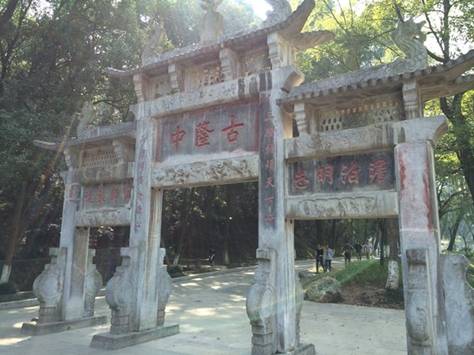
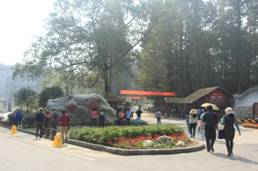

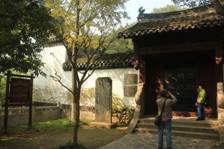
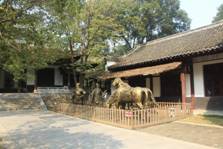
在后人心目中,诸葛亮不仅是智慧的化身,更是一代勤政廉洁的名相。因而,凡是他到过的地方,都纷纷为他立庙。各地的武侯祠就有七座。然而纪念地太多,就难以分辨真假。从古到今,谁是诸葛亮正宗纪念地而发生过不少争议。其中尤以湖北襄阳古隆中和河南南阳卧龙岗两地的武侯祠谁为“正宗”之争最为有名。 两地的武侯祠,历史都很悠久。隆中的建于晋代,保留着古朴的风貌;南阳的建于唐代,更显得宏大堂皇;两地都以诸葛亮的躬耕地自居,为武侯祠的正宗而争。为此,还打不少笔墨官司。
Zhuge Liang was not only a representative of wisdom, but also a diligent and honest prime minister. Therefore, people would build temples for him where he passed. There were seven Zhuge Liang Memorial Halls in China. There were many memorial halls, so it was difficult to distinguish them. It was a dispute which was the authentic memorial place of Zhuge Liang from ancient times. Among them, the most famous contest for authentic Zhuge Liang Memorial Hall took place between Gulongzhong in Xiangyang of Hubei and Wolong Hillock in Nanyang of Henan. Both of them had a long history. The memorial hall in Longzhong was built in the Jin Dynasty and retained the style of primitive simplicity. The memorial hall in Nanyang was built in the Tang Dynasty, which was even more magnificent. Both of them regarded themselves as the place where Zhuge Liang tilled and contested for the authentic title of Zhuge Liang Memorial Hall. Therefore, they sued lawsuits.
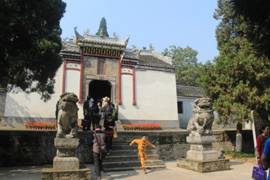
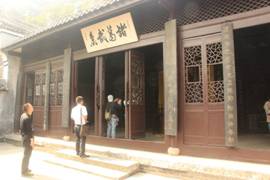
三顾堂,建于清康熙五十九年(1720),是刘备三顾茅庐、诸葛亮隆中对策的纪念堂。其外泽清荷香,茂林修竹。传说,当年刘备三顾茅庐时拴马的古柏至今耸立门前。其内金匾银对,古碑林立,具有很高的历史研究和书法艺术研究价值。
Sangu Hall was built in 1720, which is a memorial hall where Liu Bei visited the thatched cottage for three times and discussed with Zhuge Liang in Longzhong. There were clear ponds, fragrant lotus, flourishing woods and tall bamboo bushes outside it. It was said the ancient cypress used to tie the horse when Liu Bei visited the thatched cottage for three times still stood in the front of the gate. In the hall, there were many gold plaques and ancient stele, which had high historical research value and calligraphic and artistic research values.
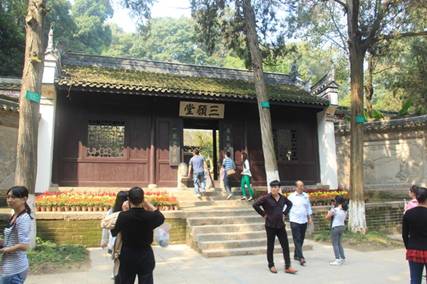
诸葛草庐----诸葛亮从17岁至27岁寓居隆中,草庐是诸葛亮日常会见宾朋的地方,刘备三顾茅庐,诸葛亮隆中对策就发生在这里。
Zhuge Thatched Cottage-Zhuge Liang lived in Longzhong when he was 17-27 years old. The thatched cottage was the place where he met his friends. The story that Liu Bei visited the thatched cottage for many times and Zhuge Liang discussed the strategy in Lonhzhong took place here.
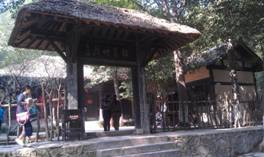
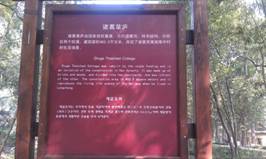
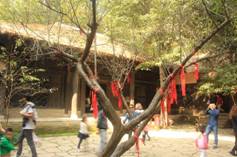
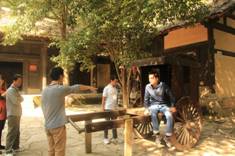
草庐亭建于清康熙年间,傍依明襄简王墓。此处本是草庐故址,明襄简王朱见淑仰慕隆中山水,于弘治二年(1489)毁草庐建陵墓。清康熙五十九年(1794),郧襄观察使赵宏恩为了纪念诸葛亮于草庐故址修建了此亭。 扇摇战月三分鼎;石黯阴云八阵图。 ——佚名摘赵宏恩诗句题草庐亭 作者简介:此联出自清康熙年间郧襄观察使赵宏恩所写的《隆中武侯草庐诗》。(注)扇摇:羽扇、纶巾是诸葛亮服饰特点,这里代指诸葛亮。战月:混战不息的年代。黯:不明,昏暗。《隆中武侯草庐诗》原文是:“汉季群奸探赤符,独吟梁父独扶孤。扇摇战月三分鼎,石黯阴云八阵图。泣鬼文成何有魏,陨星人去失吞吴。至今不泣英雄气,襄水缠绵晓夜呼。”
The thatched cottage was built in the reign of Kangxi in the Qing Dynasty, and it was adjacent to the tomb of Emperor Xiangjian in the Ming Dynasty. This place was the former site of the thatched cottage. Zhu Jianshu who was Emperor Xiangjian in the Ming Dynasty adored the landscape in Longzhong, so he ruined the thatched cottage to build an imperial tomb in 1489.In 1794, in memory of Zhuge Liang, Zhao Hongen who was the inspector in Yunxiang built this pavilion in the former site of thatched cottage. Shook a fan to command battles, divided the country into three parts; Designed eight tactical arrays in dark and cloudy days.--excerpts from Poem of Thatched Cottage by Zhao Hongen. This poem was excerpted from Poem of Zhuge Liang Memorial Hall in Longzhong written by Zhao Hongen who was the inspector in Yunxiang in the reign of Kangxi in the Qing Dynasty.(Note) Shook a fan: a feather fan and a scarf of black silk ribbon was the feature of Zhuge Liang's clothes, and it referred to Zhuge Liang here. Wartime period: wartime. Dark: not bright. Poem of Zhuge Liang Memorial Hall in Longzhong:"Traitor ministers in the Han Dynasty pursued the throne while Zhuge Liang chanted Liangfuyin to support the imperial offspring. He shook a fan to command battles, divided the country into three parts and designed eight tactical arrays in dark and cloudy days. If the goals in Memorial before a Battle were realized, the state of Wei would not exist; when Zhuge Liang died, there was no condition to conquer the state of Wu. The heroic stories were spread where Xiang River flew."

卧龙深处建于清雍正七年(1729),是诸葛亮和他的亲朋密友聚会畅怀处所。这里隆山怀抱,松鹤常鸣,庭园幽深清静。其内庞德公、黄承彦、庞统、少年诸葛亮等名人志士的塑像栩栩如生。两旁回廊里镶嵌着8块苍劲有力的石碑,一块饱经风霜的清雍正七年重修记事碑,傲然挺立在庭园中央。
Wolongshenchu was built in 1729, which was the place where Zhuge Liang and his friends gathered together. It was surrounded by mountains. Pine and cranes always sounded and the yard was quiet and profound. There were animated statues of celebrities such as Pang Degong, Huang Chengyan, Pang Tong, and yound Zhuge Liang, etc. There were 8 steles inlaid in the both sides of ambulatory. One stele which recorded the issue of repairing in 1729 stood in the middle of the yard.

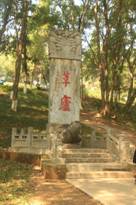

抱膝亭位于隆中山畔一高阜之上,是三层六角亭,“高四丈有奇,周七丈余”。它是湖北提督程文炳于光绪十四年(1888)所建。建造此亭目的在于后人来游来歌时联想到诸葛亮在隆中抱膝长吟时的情景,从而“慨然思巾扇之度,虽在小隐,未尝须臾忘天下事焉”。
Baoxi Pavilion was located in a high hill along Longzhong Mountain. It was a three-storey hexagon pavilion. It was about 13,3 meters in height and 23.3 in perimeter. It was built by Cheng Wenbing who was the provincial commander-in-chief in Hubei in1888.This pavilion was built for descendants to remind the scene of Zhuge Liang embraced his knees and chant invocations in Longzhong when they came to travel so that they could know that Zhuge Liang was still concerned about the national issues even when he lived in seclusion.
亭势凌云,抱膝迥留千古胜;台形丽日,观星总括万年奇。 ——佚名题抱膝亭 这副对联是建亭时镌刻在石柱上的,无题款。凌云:直上九霄。何晏<景福殿赋>:“尔乃建凌云之屈盘。”迥:遥远。台:观星台。丽日:朝阳,光彩焕发。联句表明,作者对诸葛亮预言天下三分称奇不已。
The pavilion was so high that it might reach the clouds and Baoxi Pavilion retained ancient eternal landscape. In the pavilion in a good day, people could feel the events in the history.--a poem by an unknown person in Baoxi Pavilion. This poem was inscribed on the stone posts when the pavilion was built. It was written by an unknown person. Reach the clouds: it was as high as the clouds. Ode to Jingfu Palace by He Yan: You would construct a winding building that could reach the clouds. Ancient: a long time ago. Platform: Star-gazing PlatformSunny day: the sun in the morning represented brilliance. This poem showed that the author was surprised that Zhuge Liang foresaw the division of three kingdoms.
隆中书院始建于五代天福年间,被称为“武灵王学业堂”。元代末年,广德寺书院迁到隆中,始称隆中书院。 隆中书院,1987年重建,有静砺堂、致远堂、古隆中陈列馆等建筑。隆中书院的主体,是诸葛亮与襄阳古隆中陈列馆,馆外悬挂着李先念手书的“诸葛亮纪念馆”牌匾。馆内用沙盘、雕塑以及声光电形式解析了诸葛亮所处的历史背景、三顾茅庐和隆中对策的细节。
Longzhong Academy was built in the period of Tianfu in the Five Dynasties, and it was called Learning Hall of Emperor Wuling. In the later Yuan Dynasty, the academy of Guangde Temple was moved to Longzhong, which was called Longzhong Academy. Longzhong Academy was rebuilt in 1987.The main body of Longzhong Academy was the exhibition hall of Zhuge Liang and Gulongzhong in Xiangyang. A plaque with the title of Zhuge Liang Memorial Hall written by Li Xiannian was hung outside the hall. The hall introduced the historical background of Zhuge Liang and details of visits to the thatched cottage for many times and conservation in Longzhong with sand tables, sculptures and sound & photo-electricity forms.

古隆中石牌坊建于清光绪19年(公元1893年),是隆中标志建筑,石牌坊高约6米,长约10 米,为青石、仿木结构,四柱三门楼式,十个抱鼓将四柱固定----
The memorial archway in Gulongzhong was built in 1893, which is the landmark in Longzhong, It was about 6 meters in height and 10 meters in length. It was a wood-imitation structure made with bluestone. It had four posts and three gates. Ten drums fixed these four posts.

